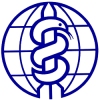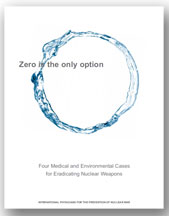Why Prevention is Still the Only Cure
Physicians first confronted the medical consequences of the use of nuclear weapons on August 6, 1945, when surviving medical personnel struggled to care for the massive casualties in the aftermath of the Hiroshima nuclear explosion:
 In a city of two hundred and forty five thousand, nearly a hundred thousand people had been killed or doomed at one blow; a hundred thousand more were hurt. The people … wept and cried, for Dr. Sasaki to hear, “Sensei! Doctor!”…. Bewildered by the numbers, staggered by so much raw flesh, Dr. Sasaki lost all sense of profession and stopped working as a skillful surgeon and a sympathetic man; he became an automaton, mechanically wiping, daubing, winding, wiping, daubing, winding.
In a city of two hundred and forty five thousand, nearly a hundred thousand people had been killed or doomed at one blow; a hundred thousand more were hurt. The people … wept and cried, for Dr. Sasaki to hear, “Sensei! Doctor!”…. Bewildered by the numbers, staggered by so much raw flesh, Dr. Sasaki lost all sense of profession and stopped working as a skillful surgeon and a sympathetic man; he became an automaton, mechanically wiping, daubing, winding, wiping, daubing, winding.
Many of Dr. Sasaki’s patients who survived the injuries caused by heat, fire, and blast soon developed the devastating features of acute radiation sickness: severe gastrointestinal problems, uncontrolled bleeding, hair loss, and extreme susceptibility to infection. With the city’s medical facilities almost entirely destroyed, effective care was virtually impossible.
 The 12.5-kiloton bomb detonated in the air over Hiroshima created ground temperatures that reached about 7,000 degrees Celsius. Of the 76,000 buildings in the city, 92% were destroyed or damaged. There were more than 100,000 deaths and about 75,000 injuries among a population of about 250,000. Of the 298 physicians in the city, 270 were dead or injured and 1,564 of 1,780 nurses died or were injured.
The 12.5-kiloton bomb detonated in the air over Hiroshima created ground temperatures that reached about 7,000 degrees Celsius. Of the 76,000 buildings in the city, 92% were destroyed or damaged. There were more than 100,000 deaths and about 75,000 injuries among a population of about 250,000. Of the 298 physicians in the city, 270 were dead or injured and 1,564 of 1,780 nurses died or were injured.
The 21-kiloton bomb detonated in the air over Nagasaki three days later leveled 6.7 million square meters (2.6 square miles). There were 75,000 immediate deaths and 75,000 injuries, with similar destruction of medical facilities and personnel and similar health consequences for the population of the city.
The physical effects of nuclear weapons include a heat (thermal) wave, a blast wave, an electromagnetic pulse, the release of ionizing radiation, and the production of isotopes, many of them radioactive. Specifically, the effects of a 10-20-kiloton nuclear weapon include:
- At the center of the blast (ground zero) the overpressures are greater than 20 pounds per square inch (psi), sufficient to destroy all but the skeletons of reinforced concrete structures.
- At approximately 0.6 mile (1.0 km) from the center of the blast, the overpressures are about 10 psi, sufficient to destroy all wood and brick-built structures.
- The blast not only destroys buildings but turns bricks, lumber, furniture, cars, and people into missiles. Overpressures on the order of 0.5 to 2 psi, which would prevail within 1.3–2.2 km of the hypocenter of a 1-kiloton blast, will turn a window into a thousand particles of glass traveling in excess of 100 miles per hour.
- The winds rushing out from the center of the blast cause air to rush back in fanning the fires produced by the thermal radiation and the initial blast damage creating a firestorm.
- In a densely populated area, injuries include tens of thousands of burns, with many of them third degree. These occur on top of thousands of crush injuries due to collapsed buildings. Hospital beds, trained personnel, and medical supplies in the immediate area are unavailable.
- Many victims would suffer from ruptured organs (particularly lungs), penetrating trauma (due to the objects that were turned into missiles), fractured skulls, and compound fractures from people having been turned into missiles until they struck any hard object.
- A significant number of people would be deafened due to ruptured eardrums.
- Many people would be blinded. The initial flash of light at the start of a detonation bleaches retinal pigments causing flash blindness for up to 40 minutes. Viewing the fireball can cause more permanent damage, including retinal burns and scars in the visual field.
Radiation exposure would result from the initial radiation flux of neutrons and gamma rays and from the fallout of the radioisotopes produced by the detonation. Radiation poses a particular problem for rescuers attempting to assess the severity of injuries since there is no way, especially in the initial period, to know whether a person has received a moderate exposure and might survive with adequate care or has received a large exposure and will die regardless of what treatment is offered.
The combinations of the diverse injuries (burns, crush injuries, ruptured organs, fractures, extensive blood loss, and radiation exposure) would multiply the likelihood that injuries would be fatal.
A 2002 study published in the British Medical Journal estimated the casualties from a 12.5- kiloton nuclear explosion at ground level near the port area of New York City. The model projected 262,000 people would be killed, including 52,000 immediately and the remainder succumbing to radiation sickness. Caring for survivors would also be difficult, if not impossible, with the loss of 1,000 hospital beds in the blast and another 8,700 in areas of high radiation exposure.
A related study published in 2002 showed that if only 300 of the weapons in the Russian arsenal attacked targets in American cities, 90 million people would die in the first half hour. A comparable US attack on Russia would produce similar devastation. Furthermore, these attacks would destroy the entire economic, communications, and transportation infrastructure on which the rest of the population depends for survival. In the ensuing months the vast majority of people who survived the initial attacks in both countries would die of disease, exposure, and starvation. Such force levels are less than one third of the nuclear weapons each country will retain after the current round of START negotiations.
Nuclear weapons present hazards in virtually all areas of their life cycle. Production and testing have their own impacts. The US National Cancer Institute estimated that the release of iodine-131 in fallout from US nuclear test explosions was by itself responsible for 49,000 excess cases of thyroid cancer among American citizens.
A 1991 IPPNW study estimated that the strontium-90, cesium-137, carbon-14, and plutonium-239 released worldwide in all nuclear test explosions would be responsible for 430,000 cancer deaths by the year 2000. Moreover, there are additional widespread health and environmental effects of nuclear weapons production as the result of massive contamination of land by radioactive materials and toxic chemicals.
 Epidemiological studies in the last decade have indicated serious health effects on individuals exposed as a result of nuclear weapons testing and manufacture. A reevaluation of the relationship between Nevada Test Site fallout and thyroid disease showed a greater than previously thought excess risk for thyroiditis at a rate of 4.9 per Gy of exposure. In addition, mortality and morbidity of United Kingdom and New Zealand military personnel involved in nuclear tests in the 1950s and 1960s was found to be worse than those who were not involved. Radioactive material releases from the Mayak nuclear weapons facility in Russia contaminated the region surrounding the Techa River and led to an additional risk of leukemias (excluding chronic lymphoid) of 4.6 times the background risk per Gy of exposure.
Epidemiological studies in the last decade have indicated serious health effects on individuals exposed as a result of nuclear weapons testing and manufacture. A reevaluation of the relationship between Nevada Test Site fallout and thyroid disease showed a greater than previously thought excess risk for thyroiditis at a rate of 4.9 per Gy of exposure. In addition, mortality and morbidity of United Kingdom and New Zealand military personnel involved in nuclear tests in the 1950s and 1960s was found to be worse than those who were not involved. Radioactive material releases from the Mayak nuclear weapons facility in Russia contaminated the region surrounding the Techa River and led to an additional risk of leukemias (excluding chronic lymphoid) of 4.6 times the background risk per Gy of exposure.



[…] *https://ippnweducation.wordpress.com/casualties-of-nuclear-war/ Share this:TwitterFacebookLike this:LikeBe the first to like this post. This entry was posted in Hypotheses and tagged 2012 Elections, Atheism, Barack Obama, MAD, Morality, Mutually Assured Destruction, Newt Gingrich, President, Religion, Rick Santorum, Thermonuclear War by Matthew. Bookmark the permalink. […]
[…] its efficacy? International Physicians for the Prevention of Nuclear War has pointed out that a 2002 study concluded that, if only 300 US nuclear weapons attacked Russian targets, 90 million Russians out of […]
[…] its efficacy? International Physicians for the Prevention of Nuclear War has pointed out that a 2002 study concluded that, if only 300 U.S. nuclear weapons attacked Russian targets, 90 million Russians out […]
[…] does work, why does Washington require 2,000 deployed nuclear weapons to ensure its efficacy? A 2002 study concluded that, if only 300 US nuclear weapons were used to attack Russian targets, 90 million […]
[…] does work, why does Washington require 2,000 deployed nuclear weapons to ensure its efficacy? A 2002 study concluded that, if only 300 U.S. nuclear weapons were used to attack Russian targets, 90 million […]
[…] its efficacy? International Physicians for the Prevention of Nuclear War has pointed out that a 2002 study concluded that, if only 300 US nuclear weapons attacked Russian targets, 90 million Russians […]
[…] why does Washington require 2,000 deployed nuclear weapons to ensure its efficacy? A 2002 study concluded that, if only 300 U.S. nuclear weapons were used to attack Russian targets, 90 million […]
[…] hundreds of thousands of people through its enormous blast, fire, and radioactive fallout. A study cited by the Nobel Peace Prize-winning International Physicians for the Prevention of Nuclear War […]
[…] hundreds of thousands of people through its enormous blast, fire, and radioactive fallout. A study cited by the Nobel Peace Prize-winning International Physicians for the Prevention of Nuclear War […]
[…] hundreds of thousands of people through its enormous blast, fire, and radioactive fallout. A study cited by the Nobel Peace Prize-winning International Physicians for the Prevention of Nuclear War […]
[…] hundreds of thousands of people through its enormous blast, fire, and radioactive fallout. A study cited by the Nobel Peace Prize-winning International Physicians for the Prevention of Nuclear War […]